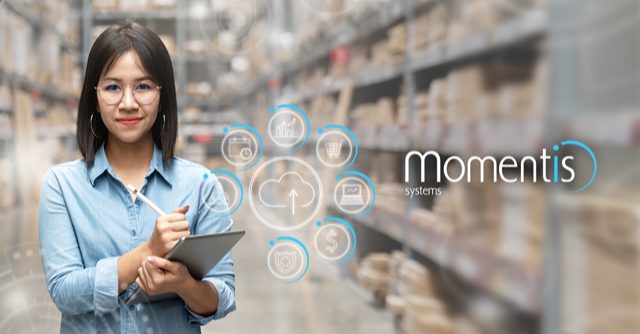
A High-Level Guide to ERP Implementation
May 11, 2021If you’re embarking on a journey to adopt an ERP, be prepared: the beginning of the project can be the most challenging. After a sometimes-lengthy analysis of your business, preparing requirements, gaining executive level sponsorship, proceeding through the vendor selection process, and finally choosing a provider, you reach the true challenge: implementation of a chosen software system. Where do you go from here?
How to Get Your ERP Implementation Done
Overwhelming as it may seem, ensuring you have an implementation strategy in place will help you to organize your processes, tasks, and accomplish your goals in respect of your timeline. Outlining the encompassing process of your project phases into bite-sized tasks is critical to your implementation success.
Software implementation requires experience, patience, and support. It is the joint effort of the company and the software vendor that ensures mutual success.
The Momentis implementation methodology uses a proven set of stage-gate phases. Enabling successful delivery across various client implementations, it has been developed around best practices and procedures derived from years of practical experience in project management, product implementation, and software development. This approach provides the following categories of services to facilitate a successful implementation of the Momentis software solutions:
Initiate
- The kick-off meeting allows for team member introductions, discussion of the various roles, review of the deliverables, and a discussion of the methodology.
- Example of roles:
- Project manager for both the client and the provider to collaborate on the deliverables throughout the project implementation, including the post-implementation period.
- Executive sponsors; one for the client and one from the vendor.
- Key team members and managers from the client and vendor.
- Discuss project plan concepts and establish weekly reporting cadence.
- Engage in timeline discussions.
Design
- Prepare solution design workshops with the teams.
- Review requirements of each business unit and determine how the solution will unite them.
- Review Hardware and Infrastructure requirements and expectations.
- Determine interface procedures that are to become part of the solution.
- Determine data migration efforts.
- Participate in playback sessions to ensure the business processes are well understood between the client and the vendor.
- Deliver the solution design document—the ultimate goal of this stage.
- Agreement on the design document is key to ensure there is a common understanding of the project tasks and the overall project deliverables.
- Establish and review the gap analysis.
During this initial stage, each team may be committed to exposing their requirements and understanding. Despite their efforts, a level of detail is only unearthed during these early steps of the design stage. Gaps in the solution may be revealed requiring discussion, resolution and completion before moving forward. Approval and formal sign-off by the company’s representative is a crucial milestone in the project. This information will serve as the basis for the proposed solution.
Build
- The build involves the finalizing of the solution.
- Finalization on the configuration of the base system data occurs.
- Where required, development and customization are schedule and transacted.
- Reporting is established.
- Vendor testing is performed, and re-works occur where required.
Deploy
- Installation and access to the system is provided to the client.
- Testing and live operations are set up.
- Data migration efforts takes place.
- Training schedules are agreed upon and performed.
- Support for user acceptance testing is provided
Closure
- The final communication and coordination of all related tasks leading to the final cutover and live processing of the new ERP.
- This stage begins at the end of the deployment stage—the user acceptance testing (UAT) phase.
- Once the UAT is successfully processed, your company can move forward with a new ERP.
- The scheduled tasks for final data migration are provided, the cut over tasks are reviewed, and the teams are updated on expectations.
- Final data loading and data migrations occurs, verified and live processing can begin.
- The Momentis project and support teams are hands-on during the live process, assisting the user community where needed and ensuring a successful transition.
Post Project
- Once the company gains experience and confidence on the new system through repetition, a post project reflection should be scheduled weeks to months following implementation.
- The goal is to ensure expectations were addressed, with discussion of any remaining gaps or phases that were determined to be addressed post-live.
- Plans for future growth and new challenges are to be discussed.
- Finally, the relationship between the company and the vendor continues as a partnership where both sides are actively working towards benefiting from the relationship.
There are numerous key stages and tasks involved in an ERP implementation process demanding cooperation and dedication from both the client and the vendor. With several sub tasks and work items at every turn of the project plan, this outline is simply the tip of the iceberg. Having an experienced ERP solution provider guide you through a seemingly overwhelming process will ensure your implementation is brought to fruition successfully and with minimal anxiety.
Whether you are interested in an entirely new ERP system or are considering changing software suppliers, Momentis can help. Contact us today for more information.
****************************************************************************************
The Momentis ERP System was developed for fashion, apparel, footwear and accessory brands, textile, wholesalers, and distributors. Momentis automates and streamlines processes from design to delivery – Product Lifecycle Management (PLM), Sourcing & Logistics, Inventory Management, Warehouse Management, Order Management and Financials – and integrates seamlessly with leading B2C, 3PL, POS and other 3rd parties using EDI and APIs. The Trenza software suite is the latest solution that enables
